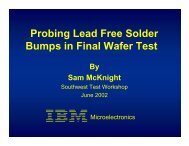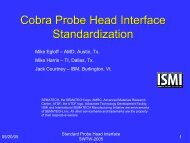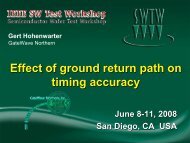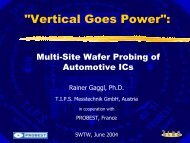July, 2002 Issue - Semiconductor Wafer Test Workshop
July, 2002 Issue - Semiconductor Wafer Test Workshop
July, 2002 Issue - Semiconductor Wafer Test Workshop
You also want an ePaper? Increase the reach of your titles
YUMPU automatically turns print PDFs into web optimized ePapers that Google loves.
Vol. 13 No. 07 THE FINAL TEST REPORT <strong>July</strong> <strong>2002</strong><br />
In what Intel’s Steve Strauss himself<br />
admits “appeared to be some<br />
thing of a contradiction” in his<br />
presentation at last months’ SWTW<br />
gathering in Long<br />
Beach, CA – he<br />
called for “singlesourced”<br />
test tooling,<br />
while at the<br />
same time asking<br />
for ‘multi-sourced’<br />
testers. As we described<br />
in this issue’s cover story, he<br />
believes that the chip industry would<br />
greatly benefit from a ‘consolidation’<br />
of tooling (probe cards, sockets, DUT<br />
boards, burn-in boards, etc.) supplier,<br />
giving chipmakers ‘turnkey’ solutions<br />
to their tooling needs.<br />
However, he took quite a different<br />
tact, in that same presentation, calling<br />
for “open architecture” VLSI ATE.<br />
(Intel has been promoting this approach<br />
to its vendors for some time,<br />
but this was one of the first ‘public’<br />
presentation of the idea beyond several<br />
papers at recent ITC meetings.)<br />
While Strauss said that the latest<br />
“modular” testers are an “evolutionary”<br />
(although one slide, top of p.2)<br />
called them "revolutionary") improvement<br />
over conventional testers – they<br />
are not sufficiently so. He said that<br />
‘conventional" testers, with their custom<br />
infrastructure are too difficult to<br />
support and improvements are only<br />
‘generational. And, they are available<br />
from only a single supplier.<br />
Modular or “<strong>Test</strong>er-on-a-Board” systems<br />
provide more flexible configurations,<br />
but are still a “closed architecture”<br />
and still are available from<br />
only a single supplier.<br />
Strauss is asking for a “revolutionary’<br />
change – to truly “open architecture”<br />
testers – by the ATE industry.<br />
Such an architecture would allow<br />
chip makers to purchase tester main<br />
frames, test heads, and modules from<br />
different suppliers. He likens it to a<br />
PC maker which has a wide choice of<br />
suppliers for each of the components<br />
in its products.<br />
IN FTR'S OPINION<br />
The result, in Strauss’ opinion,<br />
would be test equipment which truly<br />
“scale across price, performance, pin<br />
count and application requirements".<br />
He recognizes that such a “revolution”<br />
would require ‘disruptive”<br />
changes in the ATE industry. It would<br />
require the development of official or<br />
at least defacto industry standards for<br />
every tester component interface –<br />
and inevitably, standard software,<br />
along the line of Microsoft Windows.<br />
All of that would represent a 180-<br />
degree turn in ATE industry thinking<br />
– which since its beginnings more<br />
than 35 years ago has been based<br />
solely on proprietary tester architectures<br />
and software.<br />
This writer has had some relatively<br />
recent experience with the industry’s<br />
refusal to change that mind set. In<br />
1994 we began an effort to work with<br />
SEMI and equipment makers to develop<br />
‘standards’ for chip testers and<br />
related equipment. After four years of<br />
frustration – with both SEMI’s lack of<br />
interest in ‘back-end” standards and<br />
ATE makers’ almost total indifference,<br />
FTR abandoned the effort. (It<br />
has been continued – led by Xandex’s<br />
Roger Sinsheimer – but<br />
with limited results.)<br />
However, in recent<br />
months, at least two new<br />
efforts to develop standards<br />
for an “open architecture”<br />
have been quietly<br />
created.<br />
One is reportedly being<br />
led by Schlumberger<br />
CTO, Bernie West and<br />
the other by Advantest<br />
VP, Sergio Perez. Each<br />
group is attempting to<br />
develop a ‘consensus’<br />
open architecture, but<br />
doing it outside of industry<br />
groups such as SEMI<br />
and IEEE.<br />
Teradyne reportedly<br />
has not joined either<br />
group, but is already embracing<br />
ithe concept.<br />
Page 3<br />
In May it announced the creation of<br />
an Open Architecture Initiative for<br />
its newly introduced Integra FLEX<br />
test system. "This initiative enables<br />
third parties to both cooperatively<br />
and independently develop and market<br />
instrumentation options for the<br />
FLEX system. It will provide our customers<br />
with access to a wider range<br />
of instrumentation on the FLEX platform<br />
with an accelerated time to<br />
market," said Mark Jagiela, VP/GM of<br />
Teradyne's <strong>Semiconductor</strong> <strong>Test</strong><br />
Group.<br />
You can look for both groups – or<br />
perhaps a merged “consortium” – to<br />
surface publicly at SEMICON/West<br />
next month and at ITC in October.<br />
Given the present distress of the<br />
ATE industry – where most companies<br />
have little except price cuts to<br />
close orders – the time may just be<br />
right for the required mind set<br />
change.<br />
That’s my opinion,








